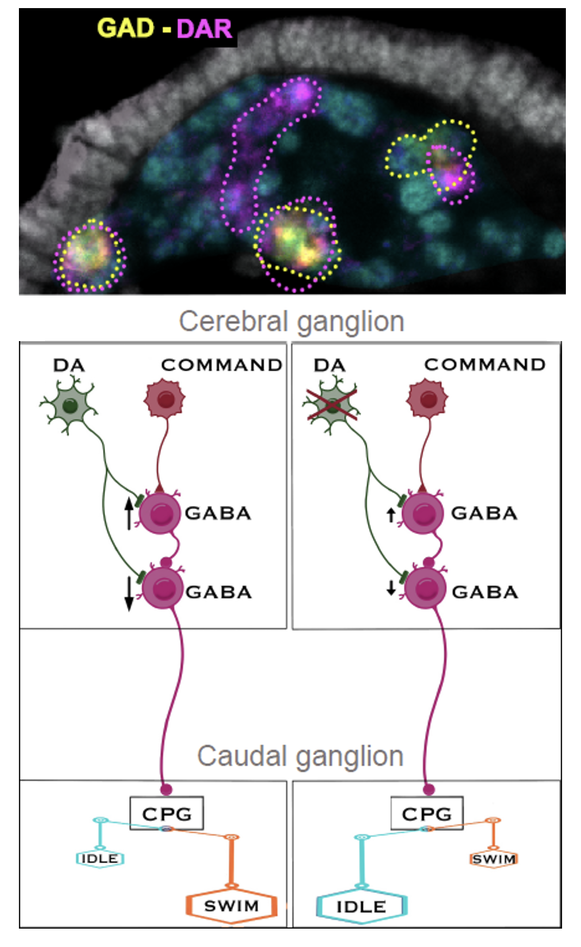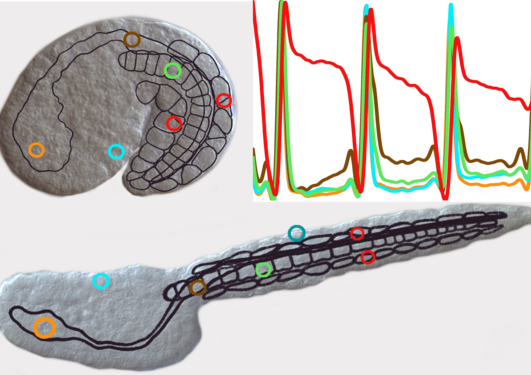An ancient neuronal network controls movement in humans and tunicates
Understanding the neural control of movement and how it evolved is critical to better address neurodegenerative diseases. In a recent study, researchers discovered that neuronal networks controlling movement in humans and tunicates have the same building blocks, structure, and function.

Main content
In a new article published in Current Biology, researchers have characterized the regions of the brain controlling movement in the tunicate Oikopleura dioica. By uncovering how motor functions are regulated in related vertebrates, researcher Oleg Tolstenkov in the Chatzigeorgiou group, staff engineer Yana Mikhaleva at the Department of Clinical Medicine, led by former Michael Sars Centre associate group leader Professor Joel Glover at the University of Oslo, hope that the findings will improve our understanding of neurodegenerative diseases disrupting our ability to move effectively, such as Parkinson’s and Huntington’s disease.
A central part of the neuronal circuits controlling movement in humans, and other vertebrates, is located in a region called the basal ganglia, deep within the brain. In the basal ganglia, the brain chemical dopamine regulates the function of inhibitory nerve cells and generates smooth movements. The team questioned whether the same movement control system exists in the animal Oikopleura dioica. "Oikopleura is an interesting species in which to ask this question because it is related to vertebrates from way back when vertebrates first arose during evolution about 600 million years ago and has a brain that is built according to the same molecular patterning scheme as the human brain," explained Professor Glover. However, the brains of tunicates have undergone significant miniaturization during evolution. The human brain has about 90 billion nerve cells, Oikopleura only has 130.
With so few neurons, researchers were unsure whether the crucial elements controlling movement in vertebrates would still be present. In the brain, there are about 400,000 neurons that use dopamine to control the basal ganglia. In Oikopleura, the authors found only two such neurons. "Given the context of dopamine's importance as a modulator in the animal kingdom, we were expecting to see at least some effect of dopamine on movement. However, the revelation that dopamine acts as a clear switch for behavior was a remarkably surprising finding," said Oleg Tolstenkov.
Yana Mikhaleva was able to reconstruct the connections made by the two dopaminergic neurons to a small network comprising about ten inhibitory nerve cells. This showed that the neural circuit was organized in a very similar fashion to the human basal ganglia. In addition, the team found that disrupting dopamine signaling within the network had an impact on the way Oikopleura moved. Inhibiting dopamine synthesis caused the animals to move in a less efficient way, which is very similar to what happens when dopamine-utilizing nerve cells are destroyed in Parkinson's disease.
The resemblance to humans is striking. As we watched the animals with dopamine deficiency struggle to initiate swimming without success, the similarity to symptoms seen in Parkinson's patients was evident. It's difficult to believe that such a significant effect could arise from the malfunction of just a single pair of tiny dopamine cells. - Oleg Tolstenkov
The exciting results indicate that the central movement-regulating circuit found in the brain of vertebrates which is so important for ensuring efficient movement in humans and other vertebrates, must have arisen before vertebrates evolved. More strikingly, this network can still function and generate efficient movement even when the number of nerve cells involved is extremely low - only a handful in Oikopleura, compared to many hundreds of thousands in humans.
For the future, Oleg hopes that this study will shed light on the understanding of the evolution of motor-control circuits in vertebrates. "We demonstrated that the probable common ancestors of tunicates and humans likely possessed comparable circuits. This insight not only paves the way for further investigations into the reconstruction of chordate circuit origins but also adds to the evolution of dopamine receptors and their function in chordates", Oleg concluded.

